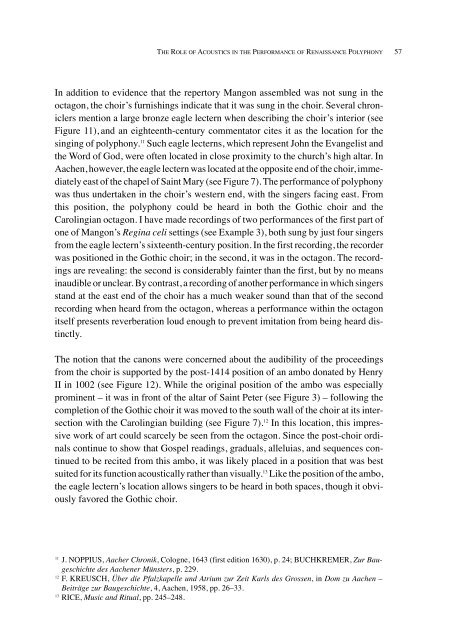YEARBOOK OF THE ALAMIRE FOUNDATION
YEARBOOK OF THE ALAMIRE FOUNDATION
YEARBOOK OF THE ALAMIRE FOUNDATION
Create successful ePaper yourself
Turn your PDF publications into a flip-book with our unique Google optimized e-Paper software.
<strong>THE</strong> ROLE <strong>OF</strong> ACOUSTICS IN <strong>THE</strong> PERFORMANCE <strong>OF</strong> RENAISSANCE POLYPHONY<br />
In addition to evidence that the repertory Mangon assembled was not sung in the<br />
octagon, the choir’s furnishings indicate that it was sung in the choir. Several chroniclers<br />
mention a large bronze eagle lectern when describing the choir’s interior (see<br />
Figure 11), and an eighteenth-century commentator cites it as the location for the<br />
singing of polyphony. 11 Such eagle lecterns, which represent John the Evangelist and<br />
the Word of God, were often located in close proximity to the church’s high altar. In<br />
Aachen, however, the eagle lectern was located at the opposite end of the choir, immediately<br />
east of the chapel of Saint Mary (see Figure 7). The performance of polyphony<br />
was thus undertaken in the choir’s western end, with the singers facing east. From<br />
this position, the polyphony could be heard in both the Gothic choir and the<br />
Carolingian octagon. I have made recordings of two performances of the first part of<br />
one of Mangon’s Regina celi settings (see Example 3), both sung by just four singers<br />
from the eagle lectern’s sixteenth-century position. In the first recording, the recorder<br />
was positioned in the Gothic choir; in the second, it was in the octagon. The recordings<br />
are revealing: the second is considerably fainter than the first, but by no means<br />
inaudible or unclear. By contrast, a recording of another performance in which singers<br />
stand at the east end of the choir has a much weaker sound than that of the second<br />
recording when heard from the octagon, whereas a performance within the octagon<br />
itself presents reverberation loud enough to prevent imitation from being heard distinctly.<br />
The notion that the canons were concerned about the audibility of the proceedings<br />
from the choir is supported by the post-1414 position of an ambo donated by Henry<br />
II in 1002 (see Figure 12). While the original position of the ambo was especially<br />
prominent – it was in front of the altar of Saint Peter (see Figure 3) – following the<br />
completion of the Gothic choir it was moved to the south wall of the choir at its intersection<br />
with the Carolingian building (see Figure 7). 12 In this location, this impressive<br />
work of art could scarcely be seen from the octagon. Since the post-choir ordinals<br />
continue to show that Gospel readings, graduals, alleluias, and sequences continued<br />
to be recited from this ambo, it was likely placed in a position that was best<br />
suited for its function acoustically rather than visually. 13 Like the position of the ambo,<br />
the eagle lectern’s location allows singers to be heard in both spaces, though it obviously<br />
favored the Gothic choir.<br />
11 J. NOPPIUS, Aacher Chronik, Cologne, 1643 (first edition 1630), p. 24; BUCHKREMER, Zur Baugeschichte<br />
des Aachener Münsters, p. 229.<br />
12 F. KREUSCH, Über die Pfalzkapelle und Atrium zur Zeit Karls des Grossen, in Dom zu Aachen –<br />
Beiträge zur Baugeschichte, 4, Aachen, 1958, pp. 26–33.<br />
13 RICE, Music and Ritual, pp. 245–248.<br />
57











